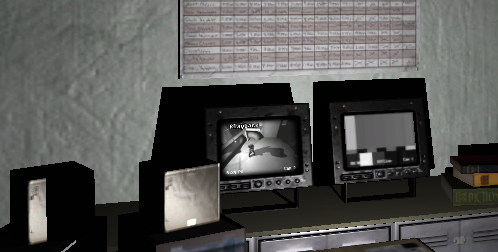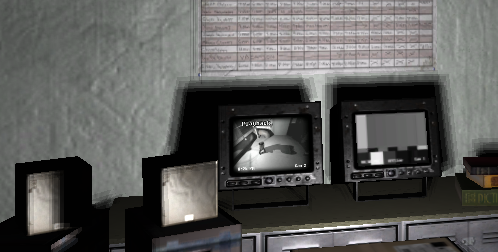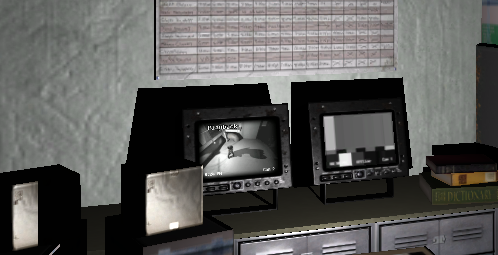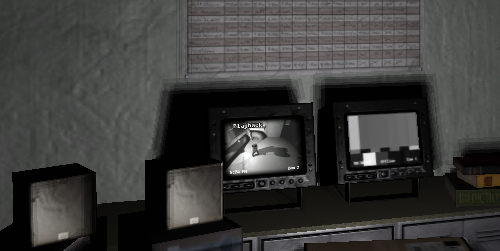F.E.A.R. GPU Performance Tests: Setting a New Standard
by Josh Venning on October 20, 2005 9:00 AM EST- Posted in
- GPUs
The Failure of Soft Shadows and Parallax Mapping
Soft Shadows
We've seen how soft shadows can be used effectively in games like The Chronicles of Riddick, and Monolith has decided to add this as an option in FEAR. Used correctly, soft shadows greatly enhance lighting in a game by giving shadows cast by objects different levels of darkness making them more realistic. This process can take up a lot of processing power however, and that's no exception for FEAR.
Basically, soft shadows are an effect that show how shadows tend to fade at the edges or cast overlapping lines on walls or objects depending on different factors such as light angle and distance. If you've ever made a shadow-puppet, you can see this clearly, as multiple outlines of your hand shadow overlap on the wall with varying degrees of darkness (depending on the light source). And if you were to move your hand closer or farther away from the light, you can see how the soft shadows change dynamically.
The idea is to capture this effect in a game environment, but as any programmer would know, translating this to a game engine can be a very complex undertaking. Not only that, but as we mentioned before, calculating multiple shadows in real time can quickly become a major leech of processing power. With FEAR, we've seen how big of a performance hit that we had when we enabled soft shadows, but you may wonder, "does the effect at least look good?"
The short answer is "no". The way that FEAR incorporates soft shadows ends up looking unrealistic; more stratified and strange than soft. It simply looks as though the game draws multiple shadows at the edges of objects and offsets them up, down, left and right very slightly at different degrees of darkness regardless of the light source. This wouldn't be so bad if the multiple shadows were not readily noticeable as such. It also would have been nice if the "blur factor" were more dynamic; in other words, moving the shadows closer together or farther apart given where the object (say an enemy soldier) is in relation to the light sources and shadowed surfaces.
This is difficult to understand until you see it happening in the game, but you can get a better idea of it by looking at a few pictures. We took some screen shots of a scene with and without soft shadows enabled with both NVIDIA and ATI cards. Please ignore the slight lighting and position differences of these screens.
Parallax Mapping
While the detailed textures, excellent lighting, well done static and dynamic shadows (in spite of the soft shadow issue), large intricate particle systems, and various beautiful effects of FEAR come together to form an immersive and fluid graphical experience, there are a few caveats. To their credit, Monolith was very aggressive with the features that they included and are on the leading edge of technology. The use of a deep parallax mapping algorithm to represent damage is a very cool idea, but the implementation used in FEAR doesn't include key features such as self-occlusion and self-shadowing. When passing a wall with a chunk blown out, the hole will swim around, flatten out, and eventually look like unidentifiable goo stuck to the wall as the angle gets very steep.
The parallax mapping used looks great from angles where the entire interior of a hole can be seen. The problem occurs at viewing angles where a near edge would need to block the view of part of (or the entire) interior of the indention. Rather than occluding anything, parts of the texture that should become invisible are still shown (albeit distorted). This completely destroys the illusion of depth at steep angles by making the texture kind of swim until it totally loses its three-dimensionality. There are algorithms available that can represent correctly self-occlusion in parallax mapping. While we can appreciate cheaper parallax mapping algorithms as a kind of upgraded bump mapping, dramatic surface deformation should either be done more correctly or not at all in cases where the viewer can move to angles that break the effect.
But again, we would love to give credit where credit is due. We would rather see game developers experiment with new technology and put something out there than let the true power of our graphics cards remain dormant. Monolith was ahead of the curve with the graphics in Tron 2.0, and they haven't let us down with the quality of FEAR.
Soft Shadows
We've seen how soft shadows can be used effectively in games like The Chronicles of Riddick, and Monolith has decided to add this as an option in FEAR. Used correctly, soft shadows greatly enhance lighting in a game by giving shadows cast by objects different levels of darkness making them more realistic. This process can take up a lot of processing power however, and that's no exception for FEAR.
Basically, soft shadows are an effect that show how shadows tend to fade at the edges or cast overlapping lines on walls or objects depending on different factors such as light angle and distance. If you've ever made a shadow-puppet, you can see this clearly, as multiple outlines of your hand shadow overlap on the wall with varying degrees of darkness (depending on the light source). And if you were to move your hand closer or farther away from the light, you can see how the soft shadows change dynamically.
The idea is to capture this effect in a game environment, but as any programmer would know, translating this to a game engine can be a very complex undertaking. Not only that, but as we mentioned before, calculating multiple shadows in real time can quickly become a major leech of processing power. With FEAR, we've seen how big of a performance hit that we had when we enabled soft shadows, but you may wonder, "does the effect at least look good?"
The short answer is "no". The way that FEAR incorporates soft shadows ends up looking unrealistic; more stratified and strange than soft. It simply looks as though the game draws multiple shadows at the edges of objects and offsets them up, down, left and right very slightly at different degrees of darkness regardless of the light source. This wouldn't be so bad if the multiple shadows were not readily noticeable as such. It also would have been nice if the "blur factor" were more dynamic; in other words, moving the shadows closer together or farther apart given where the object (say an enemy soldier) is in relation to the light sources and shadowed surfaces.
This is difficult to understand until you see it happening in the game, but you can get a better idea of it by looking at a few pictures. We took some screen shots of a scene with and without soft shadows enabled with both NVIDIA and ATI cards. Please ignore the slight lighting and position differences of these screens.




Parallax Mapping
While the detailed textures, excellent lighting, well done static and dynamic shadows (in spite of the soft shadow issue), large intricate particle systems, and various beautiful effects of FEAR come together to form an immersive and fluid graphical experience, there are a few caveats. To their credit, Monolith was very aggressive with the features that they included and are on the leading edge of technology. The use of a deep parallax mapping algorithm to represent damage is a very cool idea, but the implementation used in FEAR doesn't include key features such as self-occlusion and self-shadowing. When passing a wall with a chunk blown out, the hole will swim around, flatten out, and eventually look like unidentifiable goo stuck to the wall as the angle gets very steep.
The parallax mapping used looks great from angles where the entire interior of a hole can be seen. The problem occurs at viewing angles where a near edge would need to block the view of part of (or the entire) interior of the indention. Rather than occluding anything, parts of the texture that should become invisible are still shown (albeit distorted). This completely destroys the illusion of depth at steep angles by making the texture kind of swim until it totally loses its three-dimensionality. There are algorithms available that can represent correctly self-occlusion in parallax mapping. While we can appreciate cheaper parallax mapping algorithms as a kind of upgraded bump mapping, dramatic surface deformation should either be done more correctly or not at all in cases where the viewer can move to angles that break the effect.
But again, we would love to give credit where credit is due. We would rather see game developers experiment with new technology and put something out there than let the true power of our graphics cards remain dormant. Monolith was ahead of the curve with the graphics in Tron 2.0, and they haven't let us down with the quality of FEAR.










117 Comments
View All Comments
Le Québécois - Thursday, October 20, 2005 - link
I usually don't trust gamespot for their Hardware testing but until Anandtech comes up with a more complete test you can find more information here http://hardware.gamespot.com/Story-ST-x-2661-x-x-x">GamespotThey are testing differente CPU speed, graphic settings and RAM sizes.
smaky - Thursday, October 20, 2005 - link
You are correct. There is no excuse for not including the x850 pe. Judgin from Gamespot's review, the x850 did well. Come on guys, lets see numbers for the x850! I have one and am a ATI fanboi for the moment. LOLphotoguy99 - Thursday, October 20, 2005 - link
>lets see numbers for the x850!I would complain to ATI they are the ones pushing the heck out of new products they don't even have for sale. It's only natural this makes people more interested in X1000 line.
peldor - Thursday, October 20, 2005 - link
OK so the highest graphics settings on FEAR are completely unplayable at any decent resolution for most of us, much like the 'Ultra' quality settings in Doom3 when it came out.What about all the other settings? I suspect the 'highest' settings make little difference to the visuals, but seriously cut the framerate versus the 'high' setting.
At least a couple of benchmarks and screenshots to compare the medium/high/highest settings would be nice.
poohbear - Thursday, October 20, 2005 - link
why are u guys using nvidia beta drivers? should'nt u test w/ only official drivers?DerekWilson - Thursday, October 20, 2005 - link
I would think the complaint should be against the beta ATI drivers which are a press sample that is completely unavailable to the public in any form. At least people can download and install the 81.85 drivers from NVIDIA.In all honesty, we used unavailable FEAR enhanced drivers for ATI because NVIDIA simply performed better and we didn't want to see complaints about the 81.85 driver... But I guess you can't always get what you want. :-)
Le Québécois - Thursday, October 20, 2005 - link
Anychance you could e-mail me those press sample driver for ATI? :PLe Québécois - Thursday, October 20, 2005 - link
Oups...you read my mind Derek.DerekWilson - Thursday, October 20, 2005 - link
I've an update -- the driver we used is available here:http://support.ati.com/ics/support/DLRedirect.asp?...">http://support.ati.com/ics/support/DLRe...b1854&am...
and was listed as a fix for serious sam II. It's the 5.10a driver and was posted yesterday for public consumption.
Bingo13 - Thursday, October 20, 2005 - link
The 81.85 drivers will be WHQL approved and on Nvidia's website later today.